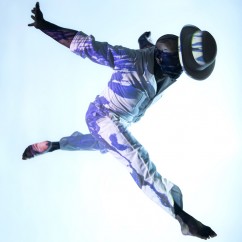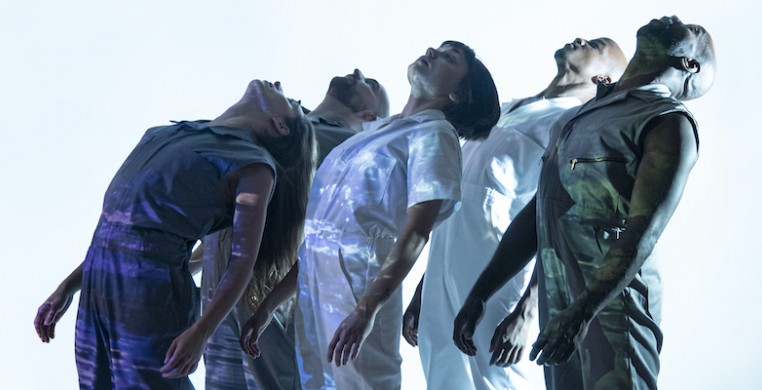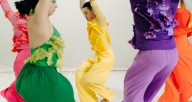A ballet about climate change? Really? Leave it to The Seldoms’ bold forays into typically un-danceable, socially-relevant issues like racism, sexism and the recession.
“Water is the space of this work,” says Carrie Hanson, artistic director and choreographer of the multi-disciplinary dance company’s newest work, “Floe,” whose title references renegade icebergs.
“We’re trying to bump up lingering denialism (about climate change) with strong evidence,” Hanson said in a recent interview with See Chicago Dance.
The Seldoms presents excerpts from “Floe” in one of several informal performances of what Hanson describes as “a little more than work-in-progress” at 7 PM this Thursday, Nov. 7th, at The Poetry Foundation. In addition to “Floe,” Thursday’s performance features Miami poet, Gabriel Ojeda-Sagué reading from his collection, “Losing Miami,” a bi-lingual exploration of what it might be like to grieve the loss of Miami due to climate change and rising sea levels.
“Start with sinking,” one of Ojeda-Sagué’s poems begins, “I was raised in a city/that could be swallowed/by the sea within/the next century.”
While “Floe” deals largely with the effect of global warming on the polar ice caps and with the devastation Hurricane Harvey wreaked on Houston, Hanson thought it would be interesting if the Poetry Foundation event introduced audiences to strong evidence of climate change in another coastal city.
“Floe” is not The Seldoms' first pass at climate change. Like “Floe,” Hanson’s 2012 piece, “Exit Disclaimer,” also addresses the differences between science and fiction, fake science and denial.
“Floe” dives deeper into the impact of climate change on coastal regions in particular. “We’re addressing conspiracy theories and delusional thinking,” Hanson said. “Most of us can agree that the Flat Earth Movement people are just off their rockers. But then we segue to Sarah (one of the dancers) shaking her head and saying, ‘The earth is flat. The earth is not warming.’”
Since the creation of “Exit Disclaimer,” which will be performed in Madison, Wisconsin next week and at Steppenwolf Theater in Chicago mid-December, “we’ve seen it happening. The evidence is there,” said Hanson. “Floe” presents more of the hard scientific facts that have recently come to light. The motif of head shaking threads through the various segments, alternately evoking the denial, oblivion, bewilderment and immutability that continue to stymie efforts to change fossil fuel emissions regulations.
For the past two years, The Seldoms and their artistic collaborators have engaged in extensive research and development, including a residency at the University of Texas in Austin, collaboration with marine biologist and environmentalist Ken Gunten, and interviews with rescuers and survivors of Hurricane Harvey in Houston.
But it all began with "Moby Dick," novelist Herman Melville’s 1851 epic tale of obsession and plunder of the sea. Hanson’s fascination with many parallels between the novel and the complex issues of global warming informs the structure of “Floe.”
 The Seldoms dancer Damon Green. Photo by A. Deran Photography
The Seldoms dancer Damon Green. Photo by A. Deran Photography
Early on in the process, Hanson brought on board scenic designer and long-time collaborator Robert Faust, along with literary adapter/script-writer Seth Bockley.
“Floe” is Bockley’s first collaboration with The Seldoms. An experienced creator/director of documentary theater, Bockley joined The Seldoms at UT-Austin in March of 2018, “just free-associating and writing" while watching the dancers. “I’m not a traditional dramatist,” he said in a phone interview. With a background in physical theater, he was especially intrigued by the dancers’ interdependence and connectedness as Hanson developed a dance sequence inspired by the“Monkey Rope” scene in the novel.
In a recent rehearsal of the scene, Hanson uses movement to create the image of strands of connecting rope with hands clasping, arms linking over, around and behind each other, the dancers undulating in a braided chain of continuous energy, suggesting we are all bound up in this together. A voice-over of “World Ocean Radio” asks which comes first—the ocean and climate change or oceanic change and the weather—connecting the image of Melville’s monkey rope to the intertwining factors of weather and oceanic change.
Bockley said he sees his text as “more tapestry than linear narrative,” mirroring Melville’s “extremely fragmentary structure in 'Moby Dick.'” He zeros in on Melville’s character of Starbuck as the ultimate corporation man who designs a personal creed to support and justify the maniacal pursuits of Captain Ahab (read: greedy oil company executives) to the ruin of everyone on board, along with the ship itself.
In one of several “sermons” mimicking Melville’s pointed use of the sermon for ironic effect in "Moby Dick", dancer Philip Elson channels Starbuck in a solo dance with spoken monologue where the physical jabs and ticks of his body language sabotage his preacherly promise that the melting icecap will open the arctic sea to “a treasure chest of fetch!”
To create “a very specific essence of place,” scenic artist Robert Faust has designed three giant, inflatable icebergs. Lightweight and easily moveable, they are 10-feet and 12-feet tall with multiple facets that can be used for projections of text and images to create scenic specificity, deliver written text and reflect light. “Each facet is a different color, like a big jewel,” Faust explained, with metallic gold and silver panels relating to commerce and greed, and blank panels to support projected animated graphic images of the arctic or abstract images of melting icebergs. “They can tilt or go flat and force limitations on space,” defining narrow corridors or opening up to an arctic landscape.
Hanson is passionate about the need to reach audiences of all kinds with the message that global warming is an immediate and dire threat to the earth and its people. “My anxiety," she said, "is, how do we get past our typical (dance) audience?” While firm in her conviction that “it’s important to be doing, necessary to be doing, and yet futile, this approach of combining science and art seems the most effective to me.”
“Floe” is Hanson’s crusade to change hearts and minds through a dance theater spectacle that hits hard truth with the beauty and lyricism and urgency that The Seldoms’ brand of athletic dance brings to a compelling subject.
--
“Floe” will premiere in Madison, Wisconsin, at the University of Wisconsin on Jan. 23, 2020, and in Chicago on Earth Day, April 22nd, at the Art Institute of Chicago. You can be sure we won’t want to miss it!
 The Seldoms dancer Damon Green. Photo by A. Deran Photography
Early on in the process, Hanson brought on board scenic designer and long-time collaborator Robert Faust, along with literary adapter/script-writer Seth Bockley.
The Seldoms dancer Damon Green. Photo by A. Deran Photography
Early on in the process, Hanson brought on board scenic designer and long-time collaborator Robert Faust, along with literary adapter/script-writer Seth Bockley.

